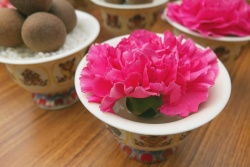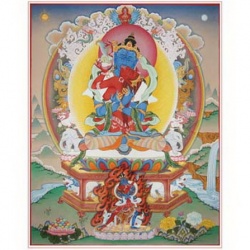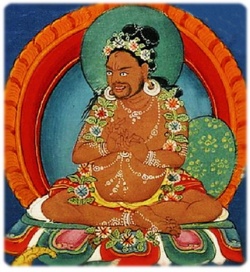Flowers mentioned in the sūtras
Flowers mentioned in the sūtras are listed below. A question mark next to the Chinese name of a plant indicates the failure to find its corresponding Sanskrit name. Then a Sanskrit name is constructed phonetically from Chinese.
Lotus which plays a key role, many other Flowers are prevalent. Among them are the nilopala which some equate with the blue water lily, and the utpala, a term used for the curly-petaled flower that in the Chinese tradition is a Symbol of longevity or renewal -- the peony. However, "utpala" is sometimes taken to mean a Lotus, and may also refer to a multi-bloomed flower such as the rhododendron that comes in many colours, or even the anemone. Theashok, which is the rose, also appears.
Mandira blossoms are Flowers characteristically offered to deities, perhaps jasmine.
The Udumbara is a Mysterious flower that blooms but once every three thousand years. It is used in Buddhist writings to stress the rare preciousness of an event or occasion.
The nomenclature is certainly rather confusing. The flower held by the Taras, and also supporting the book in images of Manjushri, is often referred to as utpala, a frilly blue flower, but the "bud" resembles the pod of a poppy, yet people also call it a Lotus.
In traditional Chinese culture (Buddhist and Taoist,) 4 distinct Flowers stand for the seasons. The Lotus signifies summertime. The China aster, or chrysanthemum indicum, which is a Symbol of Happiness and prosperity, represents autumn, and the wild plum stands for winter. The peony is the flower of renewal -- spring.
Sharira Flowers are Mysterious items that appear spontaneously as relics of Enlightened beings or at auspicious events. They are of various colours, from sky blue to pink and dark purple.
utpala (優波羅)—blue lotus
padma (波頭摩)—red lotus
kumuda (拘物頭)—white lotus
puṇḍarīka (分陀利華)—large white lotus
atimuktaka (阿提目多花)—an herbaceous plant which has fragrant red or white blooms cāka (遮迦花?)
campaka (瞻蔔)—the champaka (玉蘭) tree which has fragrant golden or white flowers
caṇa (栴那花)—the chickpea plant
canuttara (栴奴多羅花?)
kiṁśuka (甄叔迦)—the tree butea frondosa, or its bright orange-red flowers
locana (盧遮那花)—a certain plant
māndarāva (曼陀羅花)—the red blooms of the coral tree, considered as celestial flowers
mañjūṣaka (曼殊沙花)—the white blooms of an herbaceous plant, considered as celestial flowers
palāśa (波樓沙花)—the flaming orange blooms of a tree called butea monosperma, native to India and Southeast Asia
pāṭali (波羅羅花)—a tree which has fragrant purple flowers
raṇi (羅尼花?)
gauraṇi (瞿羅尼花?)
suloci (蘇樓至?)
sumana (須曼那華)—the jasmine plant, which has fragrant white, yellow, or red blooms
tāla (他邏)—the fan palm tree
udumbara (烏曇跋羅)—the ficus glomerata, a tree that produces fruit with hidden flowers. Hence the appearance of its bloom is likened to the rare appearance of a Buddha.


